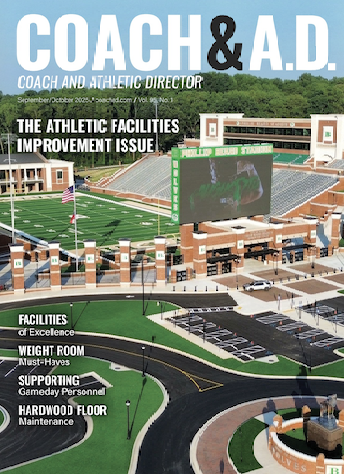Football: Turnover pursuit drills produce scoring defenses
Lakeland College, an NCAA Division III in Wisconsin, loves to get on the offensive with its defense. Its pursuit drill progression, which is conducted over three practices each week, shows how devoted the unit is in converting turnovers into points.
“It’s the lifeblood of our defense,” said Colin Bruton, Lakeland’s fourth-year defensive coordinator. “We want to get guys to the football.”
On Tuesdays during the week, Lakeland drills defenders on pursuit of the football.On Wednesdays, players break into their position groups and work on forcing turnovers. The team uses tip drills to get interceptions and fumble recoveries, such as scooping and scoring, punching the football free, or simply falling on the ball if the situation dictates.
On Thursdays, the drills are combined into practice.
“I think the thing that we do best is turn our defense into offense by attempting to score after every turnover.”
Tuesday pursuit drill
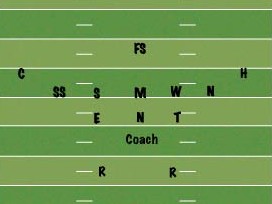 DIAGRAM 1: Our defensive players will line up in our base 3-3-5 alignment. A coach (C) will play QB, and two other defensive players will fill in as rabbits (R). The rabbits will line up 4-5 yards deep and roughly as wide as the offensive tackle.
DIAGRAM 1: Our defensive players will line up in our base 3-3-5 alignment. A coach (C) will play QB, and two other defensive players will fill in as rabbits (R). The rabbits will line up 4-5 yards deep and roughly as wide as the offensive tackle.
We will typically use agility bags to simulate the offensive line splits. The coach will go through an offensive cadence attempting to draw the defense offsides.
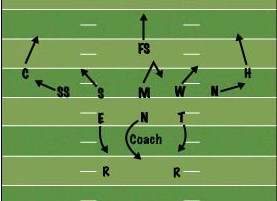 DIAGRAM 2: After the ball is snapped, the defensive players will execute the call. The defensive linemen will attack in their designated gaps, and the players designated for pass coverage will drop into their designated areas.
DIAGRAM 2: After the ball is snapped, the defensive players will execute the call. The defensive linemen will attack in their designated gaps, and the players designated for pass coverage will drop into their designated areas.
In this diagram, our call is “Base 3.”
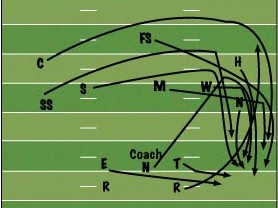 DIAGRAM 3: Approximately one to two seconds after the snap of the ball (allowing time for the defense to begin their initial pass rush-drop), the coach will point in the direction of 1 of the 2 rabbits. At that time, the rabbit will begin a sprint up the numbers on his side. The rabbit will cross the LOS just wider than the hash and will continue to and up the numbers.
DIAGRAM 3: Approximately one to two seconds after the snap of the ball (allowing time for the defense to begin their initial pass rush-drop), the coach will point in the direction of 1 of the 2 rabbits. At that time, the rabbit will begin a sprint up the numbers on his side. The rabbit will cross the LOS just wider than the hash and will continue to and up the numbers.
Once the designated rabbit is chosen and begins his path, the defenders cease their rush/drop and begin on an angle to meet the rabbit at the earliest possible spot. In doing so, the defender taps the rabbit on the hip but allow him to continue along his path. After doing so, the defender sprints through the LOS and meet the other 11 players.
Our guys always then get a break on the word swarm. The only defender that does not touch the rabbit is the back side C gap player. In the diagram, this is the end E. The backside C gap player is always responsible to be the seal and chase player, meaning he is responsible for boot or reverse.
Thursday turnover pursuit
 DIAGRAM 4: Our defensive players line up in our base 3-3-5 alignment. A coach will play QB.
DIAGRAM 4: Our defensive players line up in our base 3-3-5 alignment. A coach will play QB.
We typically use agility bags to simulate the offensive line splits. The coach goes through an offensive cadence attempting to draw the defense offsides.
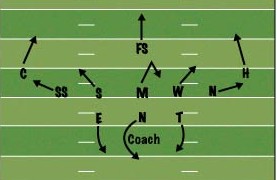 DIAGRAM 5: After the ball is snapped, the defensive players execute the call. The defensive linemen will attack in their designated gaps, and the players designated for pass coverage will drop into their designated areas.
DIAGRAM 5: After the ball is snapped, the defensive players execute the call. The defensive linemen will attack in their designated gaps, and the players designated for pass coverage will drop into their designated areas.
In this diagram, our call is “Base 3.”
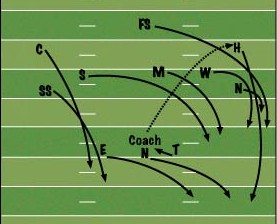 DIAGRAM 6: Approximately two to three seconds after the snap of the ball (allowing time for the defense to being their initial pass rush-drop), the coach throws the ball in the direction of one of the defensive players. On the throw, we should see all 11 defensive players moving towards the ball.
DIAGRAM 6: Approximately two to three seconds after the snap of the ball (allowing time for the defense to being their initial pass rush-drop), the coach throws the ball in the direction of one of the defensive players. On the throw, we should see all 11 defensive players moving towards the ball.
The ball should be caught by a defensive player at the highest possible point (in this case, our halfback (H) made the interception). On the catch, the defender with the ball begins his return up the nearest sideline. If the ball is caught in the middle of the field, the defender should attempt to get the ball wide as soon as possible.
The nearest defender not making the catch is always responsible for blocking the intended receiver. The defender closest to the QB is responsible for blocking the QB. All other defensive players sprint to get in front of the defender with the ball and simulate throwing a block.
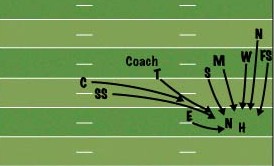 DIAGRAM 7: Upon simulating a block, the defensive players continue on a sprint well past the LOS. Often times, we will set up cones to serve at pylons for an endzone.
DIAGRAM 7: Upon simulating a block, the defensive players continue on a sprint well past the LOS. Often times, we will set up cones to serve at pylons for an endzone.
The players will meet past the goal line and will get a break on the word score.


